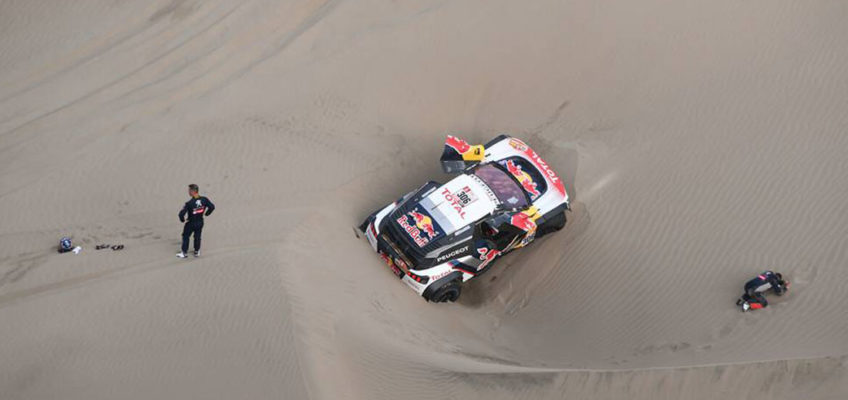by M.C. – photo: dakar.com | After just six stages of a total of 14, and having not reached yet the halfway mark of the rally, the number of Dakar casualties is already in the high eighties, 87 withdrawals Dakar to be precise, according to the official list published on the organisation’s web-page. To appreciate the significance of this figure, it in effect means that one in four vehicles that started in Peru back on the sixth of January (335 in total) are no longer in the competition. The numbers speak for themselves and reveal a very though 40th edition of the Dakar Rally. For many, including Nani Roma himself, the Rally is recovering its highly demanding African spirit, where the sand takes back centre stage (thus this year’s opening across the Peruvian dunes). On top of this, the new limitations in navigation equipment and the need for a more technical style of driving have all added to the difficulty and thrill of the legendary race.
The surprising, and cruelty-bordering gruelling, five day opening across a sea of dunes, has got the best of both amateur and great favourites for the title alike, at a very early stage of the competition. Amongst those who were expected to achieve great results but had to retire at the end was the Spaniard Nani Roma in cars (Mini) who said goodbye on the third stage after a spectacular roll at just meters from the finish line. Two days later, on the fifth day, the nine times WRC champion, Sebastien Loeb (Peugeot), got stuck in a hole in the dunes from which he had to be pulled out by a rescue track, but it was his co-pilot, Daniel Elena’s injury which left him with no option but to retire.
In motorbikes the most significant withdrawal has been that of title holder Sam Sunderland (KTM), who had to stop running, despite holding the leadership, due to an injury from a previous fall.
The ones that have lost precious time
It is not just about those that have had to retire, many have lost some precious time and in all likelihood missed their options to victory at the same time. This is the case for Qatari driver Nasser Al-Attiyah (Toyota) after getting trapped in the dunes, or for Frenchman Cyril Despres (Peugeot) whom, after damaging his vehicle with a rock and having to wait for hours for its repair, made it to the winning line in the early hours despite nobody expecting him to continue.
Even Carlos Sainz himself got stuck in the dunes during the fifth stage and Giniel De Villiers has had three burst tires and difficulties with the sand. The Spaniard Joan Barreda, in bikes, has also suffered his share of hardship despite winning two of the stages, dealing with the adversity of having to open the way as well as other navigation mishaps.
All of the above is nonetheless a mere highlights recap as, after nearly ninety withdrawals, complications have been constant during this first part of the rally, so much so that the Dakar committee has travelled from Lima to La Paz, where today participants are enjoying a rest day.
Results of the first stages
Stage winners in CARS:
- STAGE 1: Nasser Al-Attiyah (Toyota)
- STAGE 2: Cyril Despres (Peugeot)
- STAGE 3: Nasser Al-Attiyah (Toyota)
- STAGE 4: Sebastien Loeb (Peugeot)
- STAGE 5: Stephane Peterhansel (Peugeot)
- STAGE 6: Carlos Sainz (Peugeot)
Stage winners in MOTORBIKES:
- STAGE 1: Sam Sunderland (KTM)
- STAGE 2: Joan Barreda (Honda)
- STAGE 3: Sam Sunderland (KTM)
- STAGE 4: Adrien Van Beveren (Yamaha)
- STAGE 5: Joan Barreda (Honda)
- STAGE 6: Antoine Meo (KTM)
General CARS classification (up to stage 6):
- Stephane Peterhansel (Team Peugeot) 16h 25′ 02”
- Carlos Sainz (Team Peugeot) +27′ 10”
- Bernhard Ten Brinke (Toyota) +01h 20′ 41”
- Nasser Al-Attiyah (Toyota) +01h 24′ 20”
- Giniel De Villiers (Toyota) +01h 35′ 59”
General MOTORBIKES classification (up to stage 6):
- Kevin Benavides (Honda) 16h 33′ 20”
- Adrien Van Beveren (Yamaha) +1′ 57’’
- Matthias Walkner (KTM) +03′ 50”
- Joan Barreda (Honda) +9′ 33”
- Toby Price (KTM) +9′ 39”





Leave a Reply